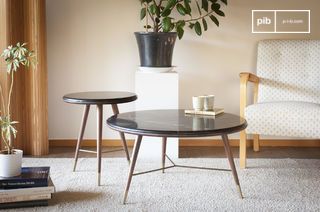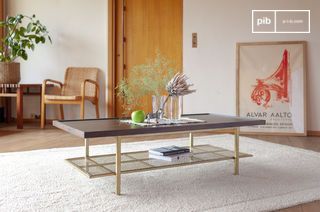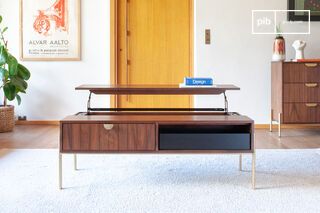Walnut coffee tables
Walnut coffee tables are based on a hardwood with warm nuances, ranging from light brown to chocolate brown. A walnut coffee table introduces a consistent visual density, suitable for sober or structured interiors. Walnut's natural grain produces a direct graphic effect, without the need for decorative additions. These models can be integrated into compositions where wood plays a balancing or balancing role. Depending on the finish (matte, oiled or satin), the perception of volume varies, influencing the luminosity and contrasts of the living room. read more >
Filters

Black marble coffee tableSivart
€765 €690-10%

Walnut coffee tableNeutra
€695 €625-10%

Walnut coffee tableHemët
€550 €495-10%

Why choose a walnut coffee table
Walnut is a dense, stable and naturally contrasting wood. A walnut coffee table exploits these properties to offer a piece that combines durability, structure and visual presence. Walnut's pronounced grain creates a graphic surface without additional decorative intervention. Walnut is particularly prized in furnishings where wood plays a functional and visual role, without overloading the space.
Walnut can be used as a solid top, as a veneer, or in combination with other materials (metal base, stone base). Its natural shade varies according to origin: American walnut (darker), European walnut (more nuanced). In all cases, the visual effect remains stable over time, as long as care instructions are followed. Walnut does not turn gray or yellow, even under indirect natural light.
Forms, finishes and uses in the living room
Walnut coffee tables come in rectangular, oval or more organic formats, depending on the desired design. The shape of the top influences the perception of the grain: an elongated top emphasizes the continuity of the pattern, while a rounded top refocuses the eye on the density of the wood. Some models use an assembly of slats or geometric cut-outs to modulate the reading of the material.
The choice of finish modifies the visual impact of the table: an oiled finish reinforces contrasts and gives a deep appearance, while a matte finish creates a softer surface, partially absorbing light. Gloss finishes are less common on walnut, as they can alter the perception of its natural grain.
A walnut coffee table can function as a center of balance in the living room. Placed on a plain or lightly structured rug, it acts as a focal point between the seats, while introducing a lively material. It is compatible with a wide variety of seating materials (textile, leather, rattan), provided that the overall reading of the space remains coherent. The density of walnut requires a precise arrangement to avoid an impression of overload or excessive contrast.
Structure, maintenance and service life
Solid walnut structures ensure excellent resistance over time. This wood does not warp easily, making it a relevant choice for everyday furniture. When used as a veneer, walnut allows for lighter shapes, while retaining the visual quality of natural wood. It is common for the base to be made from another material (powder-coated steel, painted wood, brass), to visually lighten the whole.
In terms of care, a walnut coffee table requires regular, gentle cleaning: dry or slightly damp cloth, without abrasive products. Periodic maintenance with vegetable oil preserves the shine of the oiled finish. Varnished or matt models require less attention, but must be protected from stagnant liquids or hot objects laid unprotected.
Durable, stable and visually legible, walnut is a coherent solution for structuring a living space without overdetermining its appearance. It's a wood that allows you to articulate volume and materials without creating dissonance.
Choosing a walnut coffee table means integrating a stable, expressive material capable of structuring a living room while adapting to varied compositions. Its visual density, longevity and ability to dialogue with other materials make it a functional and aesthetic choice in equal measure.
With walnut, you'll be able to create a living room that's both stable and expressive
